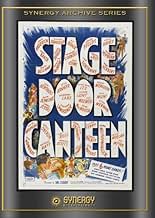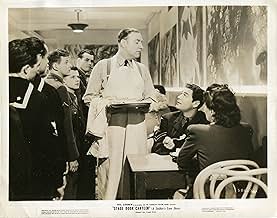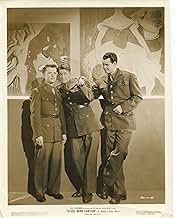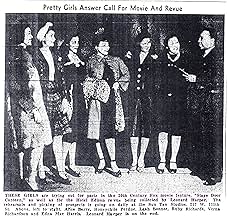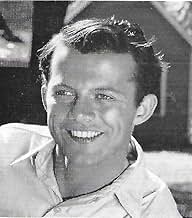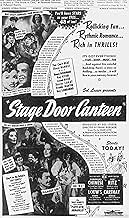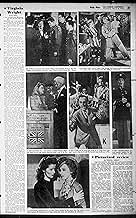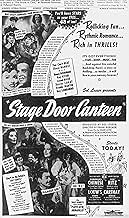Aggiungi una trama nella tua linguaA young soldier arrives in NYC and, before heading overseas to WWII, visits Stage Door Canteen, where famous actresses and entertainers volunteer to entertain soldiers.A young soldier arrives in NYC and, before heading overseas to WWII, visits Stage Door Canteen, where famous actresses and entertainers volunteer to entertain soldiers.A young soldier arrives in NYC and, before heading overseas to WWII, visits Stage Door Canteen, where famous actresses and entertainers volunteer to entertain soldiers.
- Regia
- Sceneggiatura
- Star
- Candidato a 2 Oscar
- 1 vittoria e 2 candidature totali
Recensioni in evidenza
In fact, what comes across in the film is the easy camaraderie all the young men shared with people that otherwise they had never met in their ordinary lives. Meeting the likes of Tallulah Bankhead, a woman larger than life, was almost impossible for most of the people going to war.
Some of the best actors of that era are seen doing "supporting roles" in the film. Katherine Cornell, Paul Muni, Katherine Hepburn, Alfred Lunt, Lynn Fontaine, Ina Claire, Ray Bolger, Helen Hayes, are seen interacting with the GIs and as they give them hope and courage about an uncertain future of their lives.
The film is good to watch some of these long gone theater stars in a nostalgic look at our past.
Blink and you might miss (a few names for a taster) Tallulah Bankhead, Ina Claire, Judith Anderson, Aline MacMahon, Katherine Cornell, the Lunts, George Jessel, Ed Wynn, Ralph Bellamy, George Raft, May Whitty, Harpo Marx, Ned Sparks, and Dorothy Fields. You'll remember Katharine Hepburn as she goes all patriotic at the end of the movie.
Is it a good film? Probably not, but it is certainly historically interesting and probably has the most big names in one movie. The three soldier boys stand for all their compatriots who went to war'during both that conflict and the ones which followed. They aren't glorified, but are simply depicted as young lads who like dancing with girls and being treated with courtesy. We may never know what happens to California, Dakota, and Tex (and millions like them) but 'Stage Door Canteen' gives you a bit of their lives, and a snapshot of the wartime canteen.
The film is chock-full of celebrity cameos by dozens of famous stars of the stage, screen, and radio. Most of the celebrities are identified in some way, although big-time classic movie fans should have fun spotting them first.
The movie is a product of its time, and seen many decades removed from its original context it becomes something of a time capsule, showcasing the entertainment of a past generation. Some of the names will be a bit obscure to modern audiences (particularly stage stars who didn't make many movies).* Guest stars include ventriloquist Edgar Bergen, vaudeville comedian Ed Wynn, Oscar-winners Katharine Hepburn and Paul Muni, the jazz bands of Benny Goodman and Count Basie, and various Hollywood supporting players and entertainment personalities.
Where else can you see Franklin Pangborn wash dishes with jungle man Johnny Weissmuller? Other highlights are scenes between married Broadway stars Alfred Lunt and Lynn Fontanne, a rousing song by Ethel Merman, and a comic striptease by Gypsy Rose Lee (strictly rated G -- more "tease" than "strip").
Classic movie fans will get more out of this film than the uninitiated, who might not recognize the faces or even the names that go with them. The movie works best when you can appreciate the cameos.
Don't expect much in the way of plot. Comedy bits and musical numbers are strung together by a story of young soldiers visiting the Canteen on leave before being shipped overseas and the girls they meet inside. The young romances reflect the bittersweet reality of wartime relationships.
Cheryl Walker is lovely as the ice queen hostess who comes to the Canteen for all the wrong reasons. She's looking to further her own acting career and isn't particularly interested in showing the soldiers a good time. Marjorie Riordan is cute as one of the other hostesses, who spends time with a soldier who has no sweetheart back home.
STAGE DOOR CANTEEN isn't wartime escapism. Director Frank Borzage doesn't try to distract the audience from the global situation. He keeps the audience constantly reminded, with the soldiers, sailors, airmen, and Marines that populate the Canteen and the alternately upbeat and somber patriotic tunes. Amid all the star-gazing, the film comes out in support of the U.S. servicemen, as well as America's allies in combat from Australia, the U.K., Russia, and even China. It's not hard to imagine the comfort the film must have given audiences at the height of World War II.
*The similarly-themed HOLLYWOOD_CANTEEN (1944) may have more recognizable stars, boasting some of the biggest names from Warner Bros. films (Bette Davis, Joan Leslie, Joan Crawford, John Garfield, S.Z. Sakall, Ida Lupino, Jack Carson, Sydney Greenstreet, Jane Wyman, etc.).
In that sense, the film succeeds; I was actually rather moved by the final words each boy left for his girl at the end of the film. That doesn't mean the film isn't a little saccharine though; it *has* to be--it was meant to be a morale booster during the 1940s (including, as it does, songs about shooting down Japanese planes and marching into Berlin). It rides on the strong wave of American patriotism at the time, reflecting and hoping to add to it, and even hints at an internationalism unheard of these days (the crowd cheers for Russian soldiers and carries Chinese pilots on their shoulders in tribute to their bravery). If you strip it of these time-bound scenes, however, the message and the courage remains, which is what makes STAGE DOOR CANTEEN still a film that one can enjoyably sit through not just for the glamorous star cameos. It's sweet when California keeps trying to kiss Jean and missing out (including an incredibly frustrating final attempt when someone cuts in on them when they're dancing!), and you feel just as dejected as Eileen must when she realises that Dakota *isn't* coming back this time. (Let us, for now, leave aside the fact that I can't seem to find a redeeming quality in Eileen beyond the fact that she's willing to break the canteen rules to make it up to Dakota for being mean to him at first.)
The big-name entertainment in STAGE DOOR CANTEEN really can't be faulted: there are appearances by the orchestras of Benny Goodman, Xavier Cugat and Count Basie (to name just a few!); cameos by Merle Oberon, Katharine Cornell and Alan Mowbray; and a pretty literal striptease that ends way too soon for the boys' liking by Gypsy Rose Lee. My favourite numbers would be 'We Mustn't Say Goodbye' and 'Don't Worry Island', alongside Yehudi Menuhin's beautiful rendition of 'Ave Maria' (unfortunately given under some quite terrible lighting) and the very funny opening act with Edgar Bergen and Charlie. As, essentially, the final act, Hepburn gives her few words great weight and is as striking as ever with her five minutes (tops!) of screen time.
All in all, STAGE DOOR CANTEEN is great fun to watch. It'd be even better fun if one knew all of the people making cameos in it--I could only half-guess at most of them, and I'm sure I missed many many others. A sweet, patriotic film made with a very definite purpose, and if you make allowances for that purpose, it's easy to accept the overdoing of the message, and appreciate the film for what it is... good, clean entertainment!
Lo sapevi?
- QuizThe real Stage Door Canteen at 216 W. 44th St., Times Square, was unable to be used for filming, as it was still an operating nightclub during World War II. As such, for this movie, it was re-created at R.K.O. Radio Pictures studios in Culver City, California.
- Citazioni
Katharine Hepburn: He knows what he's fighting for. He's fighting for the kind of world in which you and he can live together in happiness and peace and love. Don't ever think about quitting. Don't ever stop for a minute... working, fighting,praying until we've got that kind of a world. For you, for him, for your children... for the whole human race. Days without end. Amen.
- Curiosità sui creditiAll rights granted by the American Theater Wing which gratefully acknowledges and credits the producers, stars and members of all the theatrical unions, guilds, crafts and associations for their participation in the creation and continuance of the original Stage Door Canteen.
- Versioni alternativeThere are two versions of this film --- one that runs two hours and twelve minutes, and a shorter television version, which runs one hour and thirty-three minutes (93 minutes), which is the most common one available.
- ConnessioniFeatured in Gotta Dance, Gotta Sing (1982)
- Colonne sonoreThe Girl I Love to Leave Behind
(1943)
Music by Richard Rodgers
Lyrics by Lorenz Hart
Sung and Danced by Ray Bolger (uncredited)
Reprised as dance music near the end
I più visti
Dettagli
- Data di uscita
- Paese di origine
- Lingue
- Celebre anche come
- Stage Door Canteen
- Luoghi delle riprese
- Azienda produttrice
- Vedi altri crediti dell’azienda su IMDbPro
- Tempo di esecuzione2 ore 12 minuti
- Colore
- Proporzioni
- 1.37 : 1
Contribuisci a questa pagina


